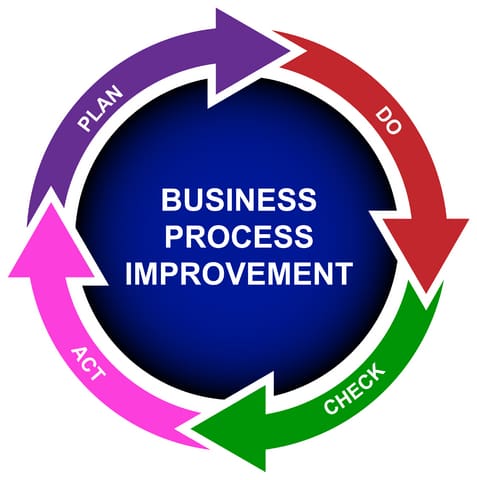This article about Lean Quality Circle was written by our guest Blogger: Dale Savage, Continuous Improvement & Training Administrator at Greenville Technology, Inc
Quality Circles have been a part of continuous improvement and associate involvement for many years. For the most part, in the United States, the members of the group meet before or after their normal work shifts for one to two hours weekly until their project is completed. In some supply bases, the team has the opportunity to also create a presentation of their work in order to compete with other suppliers in a conference setting.
The popularity of this program has varied at times and, according to the Harvard Business Review, “few QC programs turn into other kinds of programs; more commonly, decline sets in. During this period, groups meet less often, they become less productive, and the resources committed to the program dwindle. The main reason the groups continue at all is because of the social satisfaction and pleasure the members experience rather than the groups’ problem-solving effectiveness. As managers begin to recognize this, they cut back further on resources. As a result, the program shrinks.

The people who all along have resisted the program recognize that it is less powerful than it once was, and they openly reject and resist the ideas it generates. The combination of overt resistance from middle managers and staff, budget cuts, and participants’ waning enthusiasm usually precipitates the decline of the QC program.” (HBR, January 1985.)
Unfortunately the statements in the Harvard Business Review above are all too common. But does it have to be this way? Is there a way for a company to have a robust continuous improvement culture that includes Quality Circle Groups? I think if we look at some of the reasons that circle groups do not thrive we can also see what can be done to make them viable.
So here are some of the issues that I have seen in the past, having been a part of a few different Quality Circle Groups myself in the past.
- The first area is Lack of Support. This can be seen in various areas as it relates to the circle group program from the very start of the group working together to the final implementation of their improvement ideas.
Unwillingness to give ideas for quality circle group themes. Often when a quality circle group is formed and they are looking for projects or problems on which to work there is a general unwillingness for management to make suggestions. Instead they give the impression of a lack of confidence in the group from the start which builds barriers which can negatively affect the outcome of the project.
- Unwillingness to give preference to the group for the time they need to work on their project. Instead of supporting the group through making sure the team members are available to attend the meetings and to work on gathering data, testing their countermeasures, etc. There does not seem to be a perception that the team is working to improve the company.
- Unwillingness to share information with the team. Everyone understands that there is proprietary information at any company which cannot be shared publicly, but not all information about the company falls into this category. It is imperative that Quality Circle Groups have as much information as possible in order to make good decisions related to their root causes and countermeasures. I saw one group totally destroyed when the project they were working on was made unnecessary because of another change that was done in the plant. This change was in the plans but was not shared with the group when they chose their theme. This was inexcusable and had a negative effect on the program for quite a while.
- Unwillingness to have a good facilitator. Although the bulk of the work of a Quality Circle Group is done by team members, there has to be an engaged facilitator who acts as a reference person when questions arise. If a company does not provide someone who has good knowledge of the circle group steps or is not willing to put effort into helping the group, the members will flounder and the project will be less effective.
- Unwillingness to budget for circle group activity. This is a big issue, especially if the circle group program is not run effectively and does not demonstrate good ROI. Lack of money provided to make changes can stop any improvement project. Management has to modify how they see the money spent. It becomes an investment, not just another cost. Of course, this is where an ROI from the group comes into play.
- Unwillingness to have confidence in the associates to be able to make improvements that will benefit the whole company. This also shows a lack of respect for people. Of course the other items stated above adds to the frustrations that associates feel when trying to make improvements. Management wants results but do not want to be bothered with making them happen through circle groups then the groups are the ones who are suspect in their minds.

The other area that I believe contributes to the failure of Quality Circle Groups is Wrong Emphasis for the program. The results of this misplaced emphasis is the lack of support mentioned above. When a circle group program is initiated at a company the thought is that the groups are there to solve problems or do improvements quickly. Management is use to just doing what needs to be done to take care of issues and does not realize that a structured approach to problem solving may be better than just “shooting from the hip”. So they get impatient with the seemingly slow process that circle groups make, especially since they are limited to only one or two hours per week to meet. The impatience due to the wrong emphasis can kill any circle group program. So what should the emphasis be?
- Having fun should be an emphasis of a circle group. Unfortunately this is not a big selling point in many companies. The employees are there to work, not have fun and the two are mutually exclusive. This is a sad commentary on many work places. Management has to understand that people are not going to volunteer to participate in anything they do not find enjoyable. Due to the drudgery and drawn out condition that many circle groups have found themselves in, a large percentage never complete their projects. This only adds to the perception that the program is wasteful since the time spent is lost without a successful outcome.
- Learning as much as possible. Quality Circle Groups should be more about associate development than anything else. It is a great time to work with associates to help them learn about how the company works, the corporate goals and values, the roles of various people in the organization, the financial components of a process, and more. It is a time to instill in them a sense of pride in their company and purpose in their daily work. In addition they can learn the steps to problem solving and the PDCA cycle. Developing the people to be professional problem solvers through circle group activity and then empowering them to make changes needed to improve will help the company overall more than just focusing on the results of a single project. In addition, when management is working on a project or problem later in the area where the associate works, they can “speak the same language” and understand the purpose of the project and goals. They become allies on the production floor when other changes need to be made because they understand the though process that goes into those changes and the business decisions behind them.
- Making improvement is the third emphasis. Of course this has to be a part of any circle group, but the emphasis moves from number one to three. This is important because it does shows a tangible benefit to circle groups whereas the benefits from the first two may be more long-term. Completing a project also allows the members to see what they can accomplish through team work and collaboration. Without completing the PDCA cycle the associates will not reap the full value of being a part of a Quality Circle Group.
Are Quality Circle Groups outdated? Do they have a part to play in making improvements in today’s work environment?


















